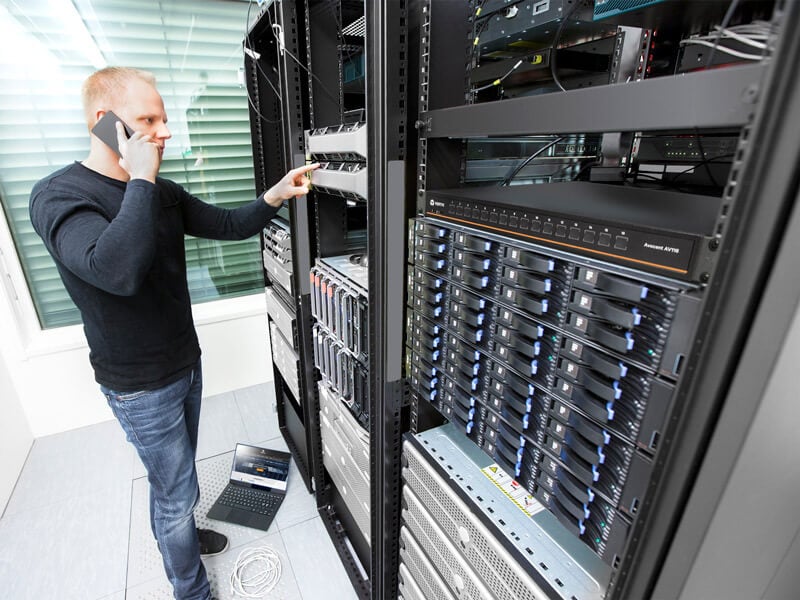The first in a new blog series covering the latest must-read market research delves into an Uptime Institute report on how the data center industry is preparing for future pandemics.
The adage, ‘hope for the best, plan for the worst’, is particularly apt for the data center industry right now.
Investment in new data center infrastructure is often based on an optimistic take of future technology demand but operators are also aggressively pragmatic when it comes to preventing downtime.
No matter what the cause – faulty equipment, cybercriminals or grid-level power outages – investment in resilient infrastructure combined with rigorous operating practices should ensure the lights stay on or, at worst, only go off for the minimum amount of time.
Unfortunately, as recently released research Post Pandemic Data Centers from Uptime Institute Intelligence points out, many operators were largely blindsided by Covid-19.
While there appear to have been relatively few (public) examples of Covid-19 related downtime over the last few months, the pandemic has put additional pressure on everything from data center design and construction to supply chains and staffing.
Preparing Your Data Center Infrastructure for Future Pandemics
Crucially, perceptive operators have also realised that Covid-19 shouldn’t be written-off as an isolated incident; pandemic planning and processes now need to be integrated into data center infrastructure resiliency strategies from the ground-up.
Or, as Uptime describes it: “COVID-19 will almost certainly not be the last pandemic – and it may only be one of many. Operators, therefore, are not making these changes in response to COVID-19, but in anticipation of future pandemics.”
So, what are those pandemic related changes specifically? Uptime sorts them into three present and future phases. The first phase is ‘reaction’ and describes the first few weeks to months and the emergency actions taken by data center operators in response. For example, reducing on-site staff numbers or introducing strict cleaning regimes.
The next phase is mitigation’ and covers the current state most operators find themselves in right now: the processes established in the reactive phase have now become ongoing actions, according to Uptime.
While those two initial phases were important in reducing much of the initial disruption from C-19, it’s the third and final phase which is arguably more important an indicative of future direction.
Reaction, Mitigation and Adaptation
As Uptime describes it, the ‘adaption phase’ is what the data center industry will be wrestling with over the next 18 months and beyond; the virus will have been largely contained (hopefully) and the focus will now be on how to minimize the impact of future pandemics.
The adaption phase covers a range of technology and operational shifts, some of which were already in play before the pandemic, adoption of which will accelerate as more operators wake up to the threat of future pandemics.
For example, Uptime, along with others in the industry (including Vertiv), believes there will be an uptick in adoption of remote monitoring and automation technology including data center infrastructure management tools (DCIM). Ninety percent of operators surveyed by Uptime said they plan to increase their use of remote monitoring/management. “…the pandemic will lead to a surge in business for DCIM, monitoring and automation vendors,” according to Uptime.
From DCIM to Prefabricated Modular Data Centers
As well as investment in remote monitoring and management, there will be a general increase in investment in both local site resiliency but also so-called distributed resiliency. According to Uptime, sixty-four percent of operators plan to increase infrastructure resiliency because of the pandemic. But conscious of the fact that a future pandemic could prevent access to an entire site, or lead to localized power outages, interest is also growing in the kind of availability zones developed by large cloud providers. Under this approach, the importance of any single site is diminished with data and workloads replicated and shared across multiple connected locations.
Other technologies which Uptime believes will be even more critical in a post-pandemic world include the use of so-called prefabricated modular (PFM) data centers. The approach – which Uptime says was firmly established even before Covid-19 – enables more of the construction process to be done under controlled factory conditions. Similarly, predictive maintenance – where close monitoring of equipment enables servicing to be done when required rather to a set schedule – was also gaining traction pre-pandemic but looks set to be more widely adopted as operators, and suppliers, look to control site visits and generally introduce smarter, AI-driven services.

So, while the continued fallout from Covid-19 might make it harder to conjure up hopeful thoughts about the future – or the near future anyway – it seems the data center industry has already learned a lot of valuable lessons when it comes to planning for the worst.






